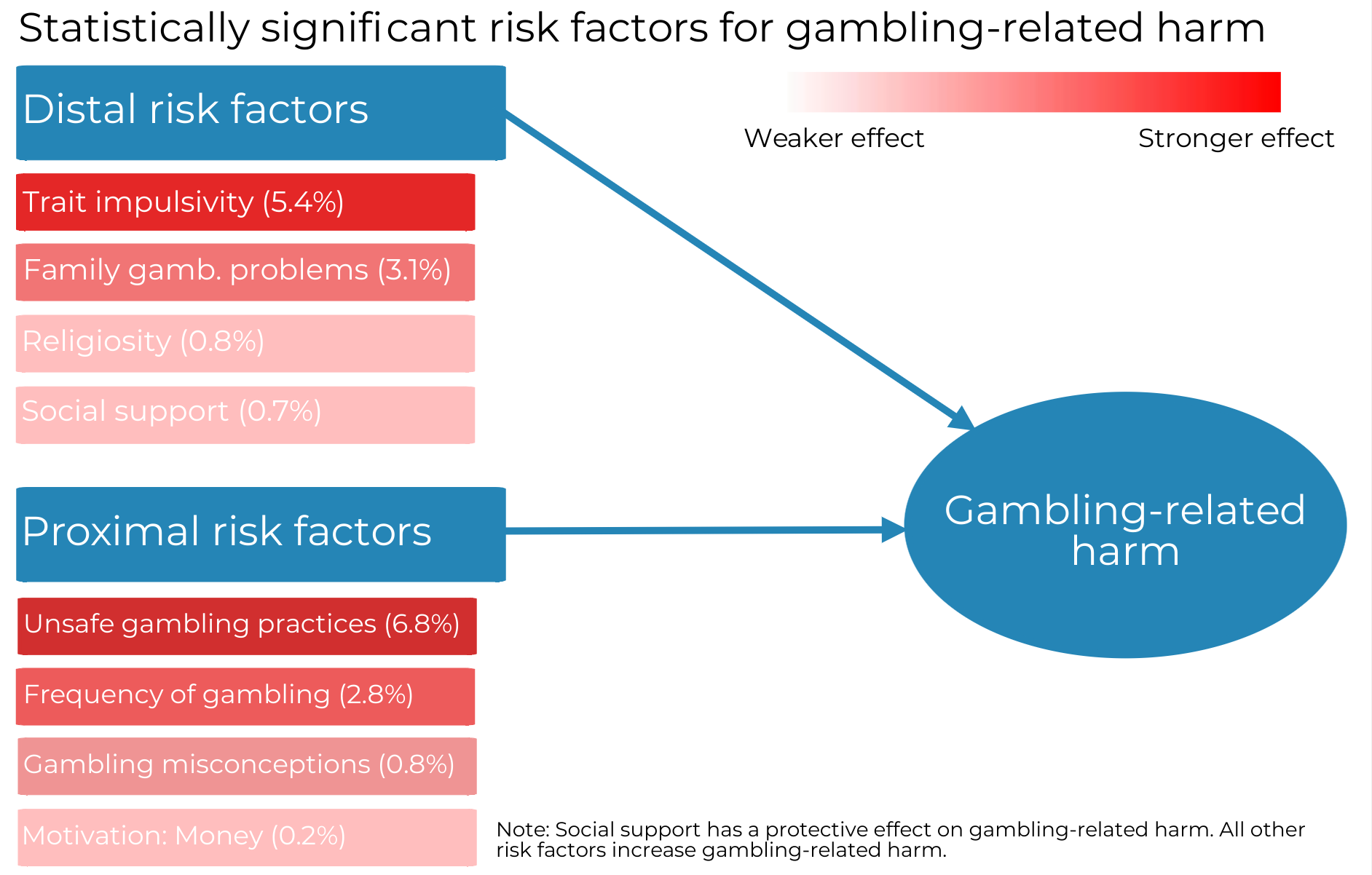Opportunities for legalized gambling have increased in the United States over the past decade. Massachusetts and New York have both expanded casino gambling and several states have legalized sports betting in recent years, leading to calls to examine gambling within a public health perspective. These trends underscore the importance of understanding the complex nature of psychological factors and life experiences that lead certain gamblers to develop gambling-related problems. This week, The WAGER reviews a study by Matthew Browne and colleagues from 2019 that examined how 25 potential individual and social risk factors predict gambling-related harm within a sample of regular gamblers.
What was the research question?
How do 25 different proximal and distal risk factors predict gambling-related harm among a sample of regular gamblers?
What did the researchers do?
The authors used an Internet panel to survey 1,174 adults who gamble at least once a month and live in Alberta, Canada. They asked respondents questions about 25 risk factors,1 gambling problems, and sociodemographic measures. Gambling problems were measured with the Short Gambling Harms Screen (SGHS). The SGHS measures financial, emotional/psychological, and relationship harms from gambling, like accumulating credit card debt and feeling shame. Using multivariate linear regression models, they tested how each of the 25 risk factors influenced gambling-related harm.
What did they find?
The distal risk factors with the strongest associations with gambling-related harm included trait impulsivity, family gambling problems, and religiosity. On the other hand, respondents with higher levels of social support were less likely to report gambling-related problems. The proximal risk factors with the strongest associations with gambling-related harm included using unsafe gambling practices,2 high frequency of gambling, having gambling misconceptions3 and being motivated to gamble to seek money.

Figure. Statistically significant risk factors for gambling-related harm. Click image to enlarge.
Notes: Statistically significant proximal and distal predictors of experiencing gambling-related harm. The percentage of the variation in problem gambling explained by each risk factor is shown in parentheses.
Why do these findings matter?
Results from this study are important for developing intervention programs that focus on reducing problem gambling in the general population. For example, education programs in casinos and public health advertising should emphasize the importance of using safer gambling practices, learning correct gambling beliefs and not gambling as a means to make money. Clinicians can also use the results of the study to better understand the specific risk factors that may make patients more likely to develop gambling-related problems.
Every study has limitations. What are the limitations in this study?
The sample in this study was drawn from only one province in Canada and used an online survey methodology, so its findings may not generalize to other locations or populations of gamblers. Using self-reported data may also reduce the validity of the findings, because respondents might not accurately report their gambling behaviors.
For more information:
Do you think you or someone you know has a gambling problem? Visit the National Council on Problem Gambling for screening tools and resources. For additional resources, including gambling and self-help tools, please feel free to visit The BASIS Addiction Resources page.
— Eric R. Louderback, Ph.D.
What do you think? Please use the comment link below to provide feedback on this article.
________________
1. The distal risk factors included: Trait impulsivity, Family gambling problems while a child, Religiosity, Social support, Being a dependent, Mental health diagnosis status, Single, Female, Count of friends who gamble, Caregiver, Gambling participation as a child, Distance to venue, Occupation: Service/Trade/Manufacturing, Work: Part-time, Unemployed or Caregiver, Education, Age, Marital status, and Household income. The proximal risk factors included gambling frequency, Safe Gambling Practices, Having gambling-related fallacies (GFM measure; reverse-coded), and Motivations for gambling (“GOES” measure; includes Money, Ego, Escape, Excitement and Social).
2. Unsafe gambling practices were measured with a nine-item scale and included questions such as “I use gambling to make money / supplement my income’ and ‘I have used cash advances on my credit card to gamble”.
3. Gambling misconceptions were measured with a ten-item scale that included “cognitive errors observed in gambling (such as ‘a positive attitude or doing good deeds increases your likelihood of winning money when gambling’). Responses are either coded as 0 (incorrect) or 1 (correct), and higher total scores reflect greater resistance to gambling fallacies” (see page 7 in article).





Raman February 11, 2020
Every study has limitations, which may include information/data related to a particular region, people may not be telling the whole truth while giving statements.